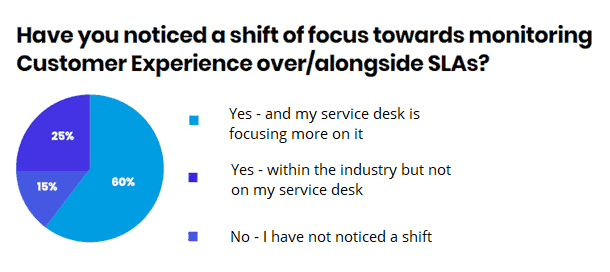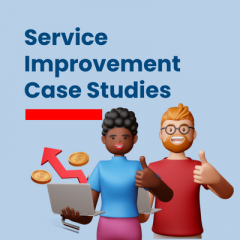
CX: Delivering Happiness
The ‘CX: Delivering Happiness’ Series is all about the shift in the ITSM industry which is beginning to steer the focus away from traditional metrics and towards recognising the significance of the customer experience. It will focus on everything from the ‘why’ and ‘how’ to measure CX, what affect it will have on service desks in the future, and even ways to take part in upcoming industry opportunities, ensuring you don’t get left behind. In part 5 we explore how XLA’s are going to effect the service desk in the future.
Part 5: The Future is XLAs
The first blog in this series explored the theory that service desk professionals find more value in Customer Satisfaction (CSAT) measures and Customer Experience (CX) than traditional metrics, and shared recent SDI data which shows that 75% of the industry have noticed a shift of focus towards monitoring CX over or alongside SLAs.

This trend the industry seems to be following could potentially lead to the uptake of eXperience Level Agreements (XLAs). Similar to Service Level Agreements (SLAs), XLAs establish a typical level of service a customer should receive. However, the difference is that XLAs focus on the customer experience and how the service desk is performing in relation to KPIs that are more directly related to what the customers sees, hears, and feels about the service (i.e. their experience).
One of the main benefits of XLAs over SLAs is the notion that targets drive behaviour. For example, SLA might outline a target for resolution times, therefore service desk analysts may attempt to resolve incidents as quickly as possible to meet the target, but in doing so they may not be attentive to the customer or their needs. As such, an XLA would allow the analyst the time and space to be mindful of the experience of the customer and ensure that they are satisfied throughout their interaction with the service desk.
Furthermore, CX can be a more effective way of monitoring the usability and efficiency of self-service or chatbots support channels, i.e. channels where the customer does not directly contact a member of support staff. Traditional metrics relating to these support channels may only skim the surface, whereas gearing KPIs or XLA targets towards a more customer-centric focus, the service could gain a better insight into the channels and highlight areas for improvement.
Service Desk Professionals’ comments
As part of the CX report, we wanted to hear from service desk professionals about their thoughts on CX, and some responses discuss SLAs and how they are becoming obsolete in their current state.
Some noted that SLAs are still necessary for monitoring the performance of the service desk and are more pertinent to business and management stakeholders, but CX is essential for understanding whether the work the service desk does is meaningful and appreciated by customers.
“SLAs are just business numbers that mean nothing to end users. Measurements need to mean something for the customer and at the end of the day Service Management is about delivering good customer service and that can only be measured by the customer’s satisfaction.”
Others were even more critical of SLAs, stating that they no longer enable IT support to effectively monitor their performance to a standard which keeps the customer happy.
“Performing to an SLA target is not good enough in this digital age. Customers expect the service they receive in other areas of their lives and expect the experience to be one of simplicity, always available, and fulfilling their needs at the time. Those things keep customers coming back, not just performing to the targets.”
What makes an XLA?
The industry is moving towards a more customer-centric way of delivering a service, and therefore XLAs are growing in relevance. A big part CX is the quality of the service as well as it’s efficiency. Therefore, it can be useful to have some KPIs around the quality of the service. Some indicators of quality include:
- Consistency across IT support services
- Keeping customers updated on the progress of their ticket
- Analysts exhibit and use Emotional Intelligence
- Analysts have good knowledge about products and services
One of the criticisms of using CX or XLAs to monitor the success of a service desk is that experience is subjective and is not as black and white as more traditional metrics. SLA targets are important for the service desk and the business to monitor performance and identify areas for improvement. Therefore, it may seem too dangerous to monitor the service quality and efficiency solely on a subjective metric.
Good news: you don’t have to go that far. An XLA can simply be made up of more CX-oriented metric targets or KPIs. The targets could be discussed with customer representatives to establish service levels which both parties agree on. Some examples could be:
- Average Call Wait Time/Response Times
- First Time Fix
- % Tickets Resolved Same Day
- Re-Opened Tickets
- Daily/Weekly CSAT
Evidently, the metrics listed are not subjective; in fact, they are probably very similar to the metrics you already measure but bundled together to help monitor the indicators of and influences on CX. This method is closely related to a balanced scorecard.* Furthermore, the metrics you use should be tailored to your service, so you can focus on what keeps your customers happy.
*Balanced Scorecards are a way of removing the bias of measuring metrics by using a variety of data in creating an average score. If you’d like to find out more about balanced scorecards, take a look at our Metrics Training Workshop, dates featured on our Training Calendar.
Looking to improve your customer perception?


























